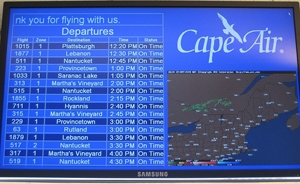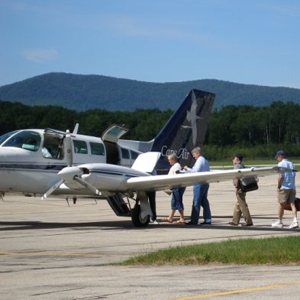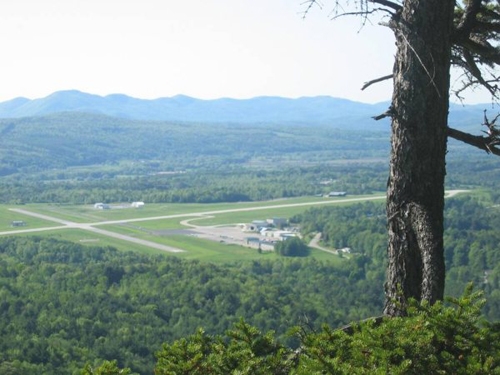
(Host) It’s been almost a year since Dave Carman took over as manager at Rutland-Southern Vermont Regional Airport.
He says passenger service in and out of Rutland is the highest it’s been in 20 years.
But as VPR’s Nina Keck reports, a lack of airfield improvements is preventing even more growth at the airport.
(Sound of airplane)
(Keck) Dave Carman points to a nine-seat commuter plane that’s preparing for take off. The airport manager says Cape Air, the Massachusetts-based company that provides passenger service to Rutland, has made the most of its small planes and affordable, three-a-day flights to and from Boston. But he says Rutland’s airport is losing out on a lot more potential business because it can’t accommodate larger planes.
 (Carman) "I think the biggest shortcoming is the length of the runway is 5,000 – and it hasn’t been enhanced since 1957. And we’re trying to accommodate a lot of aircraft that want to come in here. But when you have snow, they end up going to Keene, New Hampshire, Lebanon, New Hampshire, or over to one of the other airports in New York state."
(Carman) "I think the biggest shortcoming is the length of the runway is 5,000 – and it hasn’t been enhanced since 1957. And we’re trying to accommodate a lot of aircraft that want to come in here. But when you have snow, they end up going to Keene, New Hampshire, Lebanon, New Hampshire, or over to one of the other airports in New York state."
(Keck) Federal law requires airports to have extra runway space in case problems or bad weather arise. If Rutland wants to accommodate larger, heavier planes, they’ll need an additional one thousand feet of runway. Carman says to get that, they’ll need to push the existing runway north and carve out an underpass for Route 103. With a price tag in the tens of millions of dollars, he says funding is a big obstacle.
(Carman) "It’s a huge expense, but in the overall picture I think it’s not. Because the benefit will far outweigh the cost. It’s tough to get to this area. And having that high speed access to this area will make that investment seem like it’s very small."
(Keck) Carman says being able to accommodate larger, corporate planes, regional jet connections to cities like Philadelphia or New York; or charter planes that could bring in 50 skiers at a time would be a boon to the region. Local pilot Peter Fisk says the runway situation is also costing the state in lost fuel tax revenue.
(Fisk) "Last winter for example we had a plane arrive from Houston Texas. A quick turnaround they dropped off their passengers and went on their way. But we noted they only went as far as Albany. And we assume that was because the weight of the airplane. If they fully fueled they would not have been able to use our runway because at 5,000 feet it was not sufficient to lift the fuel."

(Keck) Fisk says last year the airport generated over $54,000 in fuel tax revenue. He says that amount could be significantly higher if larger planes were able to fill their tanks. In addition to lengthening the runway, Fisk and Carman say Rutland also needs instrument landing capabilities. Over the last several years millions of dollars have been invested in new lighting and approach beacons. But one last piece, which helps pilots determine their angle of descent, has not yet been installed.
Sue Haigh, with Vermont’s Federal Aviation Administration says the equipment has been approved for Rutland. But she says the nearly two million dollars needed was not included in this year’s budget. Dave Carman says that’s frustrating because competing airports in New York and New Hampshire already have the technology.
For VPR News, I’m Nina Keck in Rutland.